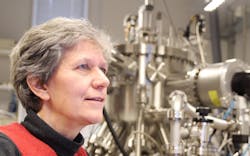Laser processing improves mid-IR semiconductor-core optical fibers
Semiconductor-based optical fibers that transmit in the mid-infrared region can potentially accomplish things that silica-glass-based fibers cannot, such as inherent photodetection and light emission. Photodetection can be done by III-V and IV semiconductors, while light emission can be done using III-V semiconductors.
Researchers at the Norwegian University of Science and Technology (NTNU; Trondheim, Norway) are now creating optical fibers consisting of both III-V and IV semiconductors, and are modifying their properties using CO2 laser processing. The devices combine potential gallium antimonide (GaSb, a III-V semiconductor) light emitters within infrared light-transmitting silicon (a IV semiconductor) optical fiber.
To create the fiber, the researchers draw a molten-core GaSb/Si core-mix preform into a fiber with a 150 μm core, which has small crystals of GaSb embedded in the SI and aligned with the fiber's axis. They then heat the fiber with a CO2 laser to further segregate the GaSb regions, regrowing the silicon around them. The laser beam first melts the GaSb and then through heat transfer melts parts of the silicon, allowing the GaSb blobs to move and reshape. The GaSb-rich regions were formed along the moving focus of the laser beam, allowing GaSb crystals up to 1.4 mm long to be created within the silicon.
The researchers used light at 1064 nm to cause the GaSb crystals to photoluminesce at around 1600 nm, showing that the crystals were of high quality.
"Our results are first and foremost a step towards opening up larger portion of the electromagnetic wave spectrum for optical fiber transmission," says researcher Ursula Gibson.
Source: https://geminiresearchnews.com/2019/05/why-you-should-care-about-better-fiber-optics/
REFERENCE:
1. S. Song et al., Nature Communications (2019); https://doi.org/10.1038/s41467-019-09835-1.
About the Author
John Wallace
Senior Technical Editor (1998-2022)
John Wallace was with Laser Focus World for nearly 25 years, retiring in late June 2022. He obtained a bachelor's degree in mechanical engineering and physics at Rutgers University and a master's in optical engineering at the University of Rochester. Before becoming an editor, John worked as an engineer at RCA, Exxon, Eastman Kodak, and GCA Corporation.

